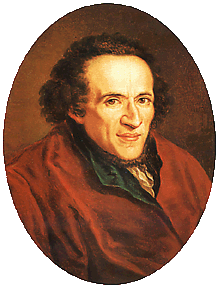Commentators:Moses Mendelssohn/0
< Commentators:Moses Mendelssohn
Jump to navigation
Jump to search
Version as of 12:48, 2 November 2015 by Eddy.Breuer (talk | contribs)
Moses Mendelssohn – Intellectual Profile
This page is a stub.
Please contact us if you would like to assist in its development.
Please contact us if you would like to assist in its development.
 | |
| Name | Moses Mendelssohn, Moses of Dessau משה מנדלסון, משה בן מנדל מדעסוי, רמבמ"ן |
|---|---|
| Dates | 1729-1786 |
| Location | Germany |
| Works | Be'ur (ed.) |
| Exegetical Characteristics | |
| Influenced by | R. David Frankel |
| Impacted on | |
Background
Life
- Name – Moses Mendelssohn
- Hebrew name – Mosheh ben Mendel
- _ name –
- Dates – 1729-1786
- Location – Dessau, Berlin
- Education – Studied in Dessau under R. David Frankel, the author of Korban Edah to the Talmud Yerushalmi; continued to study with R. Frankel in Berlin, but also studied with R. Yisrael b. Moshe of Zamosc, the author of the commentary Otzar Nehmad to the Kuzari. Virtually all his general education was obtained on his own.
- Occupation – Managed and later was part owner of a silk manufacturing business.
- Family – Married and had six children who survived to adulthood; they were between 5 and 22 years old when he died.
- Teachers – see Education, above
- Students – Mendelssohn was neither a teacher in a formal or informal sense; although many were interested in his ideas, he never referred to them as students.
- Time period – Mendelssohn lived at the time of the Enlightenment, but the German adherents of the Enlightenment with whom he interacted and corresponded were far more moderate than the thinkers associated with the French Enlightenment. The latter were often hostile to religion, whereas almost all the German Aufklärer were Christians who remained deeply committed to their church but sought to enlighten their religion from within.
Works
- Biblical commentaries – Mendelssohn wrote a commentary to Qohelet (1770), and then published Sefer Netivot ha-Shalom, which included his German translation of the entire humash, a Hebrew commentary titled Be'ur, and the Tiqqun Soferim, a masoretic commentary. This humash also included three lengthy introductions; one devoted to defending the masoretic Bible down to the niqqud and te'amim, one on the history of Bible translations, and a third devoted to the principles of translation.
- Jewish thought – He wrote a commentary to Millot ha-Higayon, the treatise on logic attributed to the Rambam.
Torah Commentary
Characteristics
- Authorship of the work – Mendelssohn translated the entire humash into German, but the Be'ur was written by different individuals. Mendelssohn himself wrote the Be'ur to parashat bereshit, all of Sefer Shemot, and substantial portions of Sefer Devarim. Shlomoh Dubno wrote the remainder of the commentary to Sefer Bereshit and contributed some notes to Shemot. Naphtali Hirz Veizel (Wessely) wrote the commentary to Sefer Vayiqra; Aaron Jaroslav penned the Be'ur to Bamidbar; and Herz Homberg wrote part of the commentary to Sefer Devarim, although Mendelssohn found it to be wanting and re-edited those sections.
- Language – the Be'ur was written in Hebrew, but it was the beginnings of a 'new' Hebrew that strove to be more clear and transparent than the Hebrew often used in the early modern period. The authors of the Be'ur nonetheless drew their terminology from medieval Hebrew literature, from both parshanut and philosophical writings.
- Peshat and derash – Mendelssohn, Dubno, and Veizel were the first moderns to focus on the need to harmonize peshat and derash, and to provide something more systematic and consistent than what the medievals had provided. Mendelssohn set down his ideas in the introduction to his work on Qohelet, which he reiterated in his introduction to Sefer Netivot ha-Shalom, and which he and Dubno applied in their respective sections of the Be'ur. Veizel explained his approach - which differed from Mendelssohn - in his introduction to Sefer Vayiqra.
Methods
- –
Themes
- –
Editions / Re-printings
- There were over two dozen editions of Sefer Netivot ha-Shalom printed between 1783 and the 1860s, making it one of the most widely printed humashim of the nineteenth-century.
Sources
Significant Influences
- Earlier Sources –
- Teachers –
- Foils –
Occasional Usage
- –
Impact
Later exegetes
- – Virtually all the nineteenth century parshanim were familiar with Sefer Netivot ha-Shalom; some, like R. Isaac Reggio, modeled their own translations and commentaries on Mendelssohn's humash; others, like R. Meklenburg's Ha-Ketav ve-ha-Qabbalah, cited from it regularly. Later exegetes like Malbim and Netziv certainly knew the work and one can detect comments that were written with the Be'ur in mind.
Supercommentaries
- –